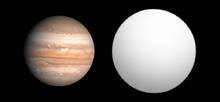
CoRoT was a space telescope mission which operated from 2006 to 2013. The mission's two objectives were to search for extrasolar planets with short orbital periods, particularly those of large terrestrial size, and to perform asteroseismology by measuring solar-like oscillations in stars. The mission was led by the French Space Agency (CNES) in conjunction with the European Space Agency (ESA) and other international partners.
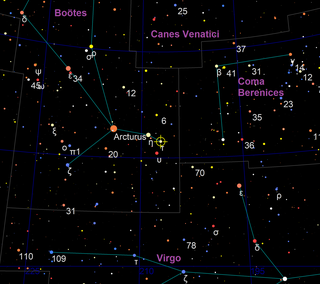
Tau Boötis, Latinised from τ Boötis, is an F-type main-sequence star approximately 51 light-years away in the constellation of Boötes. It is a binary star system, with the secondary star being a red dwarf. As of 1999, an extrasolar planet has been confirmed to be orbiting the primary star. In December 2020, astronomers may have detected, for the first time, radio emissions from a planet beyond the Solar System. According to the researchers: "The signal is from the Tau Boötis system, which contains a binary star and an exoplanet. We make the case for an emission by the planet itself."
14 Andromedae, abbreviated 14 And, also named Veritate, is a single, orange-hued giant star situated approximately 247 light-years away in the northern constellation of Andromeda. It is dimly visible to the naked eye with an apparent visual magnitude of 5.22. The star is moving closer to the Earth with a heliocentric radial velocity of −60 km/s. In 2008 an extrasolar planet was discovered to be orbiting the star.

CoRoT-1b is a transiting extrasolar planet approximately 2,630 light-years away in the constellation of Monoceros. The planet was discovered orbiting the yellow dwarf star CoRoT-1 in May 2007. The planet was the first discovery by the French-led CoRoT Mission.

HAT-P-6b is a transiting extrasolar planet discovered by Noyes et al. on October 15, 2007. It is located approximately 910 light-years away in the constellation of Andromeda, orbiting the star HAT-P-6. This hot Jupiter planet orbits with a semi-major axis of about 7.832 gigameters, and takes 92 hours, 28 minutes, 17 seconds and 9 deciseconds to orbit the star. It has true mass of 5.7% greater than Jupiter and a radius 33% greater than Jupiter, corresponding to a density of 0.583 g/cm3, which is less than water.

CoRoT-2b is the second extrasolar planet to be detected by the French-led CoRoT mission, and orbits the star CoRoT-2 at a distance of 700 light years from Earth towards the constellation Aquila. Its discovery was announced on 20 December 2007. After its discovery via the transit method, its mass was confirmed via the radial velocity method.

CoRoT-3b is a brown dwarf or massive extrasolar planet with a mass 21.66 times that of Jupiter. The object orbits an F-type star in the constellation of Aquila. The orbit is circular and takes 4.2568 days to complete. It was discovered by the French-led CoRoT mission which detected the dimming of the parent star's light as CoRoT-3b passes in front of it.
CoRoT-4 is a yellow-white dwarf main-sequence star in the constellation Monoceros.

CoRoT-7b is an exoplanet orbiting the star CoRoT-7 in the constellation of Monoceros, 489 light-years from Earth. It was first detected photometrically by the French-led CoRoT mission and reported in February 2009. Until the announcement of Kepler-10b in January 2011, it was the smallest exoplanet to have its diameter measured, at 1.58 times that of the Earth and the first potential extrasolar terrestrial planet to be found. The exoplanet has a very short orbital period, revolving around its host star in about 20 hours.
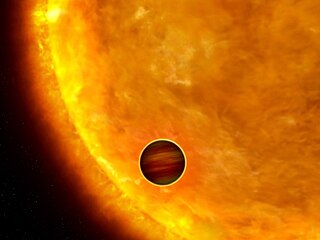
CoRoT-1 is a yellow dwarf main sequence star similar to the Sun. The star is located approximately 2,630 light-years away in the constellation of Monoceros. The apparent magnitude of this star is 13.6, which means it is not visible to the naked eye; however, it can be seen through a medium-sized amateur telescope on a clear, dark night. The first exoplanet discovered in the course of the CoRoT mission orbits this star; it is considered to be a "hot Jupiter", and is approximately as massive as the planet Jupiter itself.
CoRoT-2 is a yellow dwarf main sequence star a little cooler than the Sun. This star is located approximately 700 light-years away in the constellation of Aquila. The apparent magnitude of this star is 12, which means it is not visible to the naked eye but can be seen with a medium-sized amateur telescope on a clear dark night.
CoRoT-3 is a white-yellow dwarf main sequence star hotter than the Sun. This star is located approximately 2560 light-years away in the constellation of Aquila. The apparent magnitude of this star is 13, which means it is not visible to the naked eye but can be seen with a medium-sized amateur telescope on a clear dark night.
CoRoT-7 is a binary star system. The primary, CoRoT-7A is a G-type main sequence star, slightly smaller, cooler, and younger than the Sun. It has an apparent magnitude of 11.67, fainter than Proxima Centauri, the nearest star to the Sun. This star is approximately 520 light-years away from the Solar System in the constellation Monoceros.
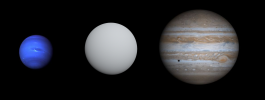
CoRoT-8b is a transiting exoplanet orbiting the K-type main sequence star CoRoT-8 1,050 light years away in the equatorial constellation Aquila. The planet was discovered in April 2010 by the CoRoT telescope.
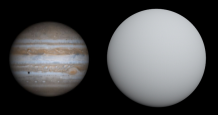
CoRoT-16b is a transiting exoplanet orbiting the G or K type main sequence star CoRoT-16 2,433 light years away in the southern constellation Scutum. The planet was discovered in June 2011 by the French-led CoRoT mission.
CoRoT-19b is a transiting exoplanet found by the CoRoT space telescope in 2011.
HAT-P-21 is a G-type main-sequence star about 910 light-years away. The star has amount of metals similar to solar abundance. The survey in 2015 has failed to detect any stellar companions. The star is rotating rapidly, being spun up by the tides of giant planet on close orbit.
BD+00 316, also known as WASP-71 since 2019, is an F-class main sequence star about 1200 light-years away. The star is younger than the Sun at approximately 3.6 billion years, yet is already close to leaving the main sequence. BD+00 316 is enriched in heavy elements, having 140% of the solar abundance of iron.
CoRoT-16 is a solitary star located in the equatorial constellation Scutum. With an apparent magnitude of 16, it requires a powerful telescope to be seen, and is located 2,400 light years away based on parallax.
